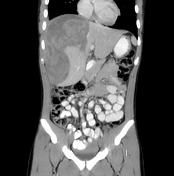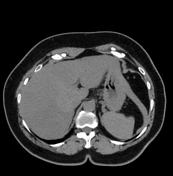3,747 results found
Article
Choledocholithiasis
Choledocholithiasis denotes the presence of gallstones within the bile ducts (including the common hepatic duct/common bile duct).
Epidemiology
Choledocholithiasis is relatively common, seen in up to 20% of patients undergoing cholecystectomy for gallstone-related complaints 2.
Clinical prese...
Article
Mickey Mouse sign (disambiguation)
In medical imaging, a Mickey Mouse sign or appearance has been given to imaging features that mimic Mickey Mouse when viewed from the front. It has been described in the following:
anencephaly 2
progressive supranuclear palsy 1
synonymously with a finger in glove sign
the flared shape of the...
Article
Anastomosing hemangioma
Anastomosing hemangiomas are benign vascular neoplasms consisting of thin-walled anastomosing vessels. These lesions have been just added to the WHO classification of soft tissue tumors in 2020 as a separate entity 1-3
Epidemiology
Anastomosing hemangiomas are rare lesions with a wide range of...
Article
Extrapulmonary tuberculosis
Extrapulmonary tuberculosis (TB) refers to the hematogenous spread of Mycobacterium tuberculosis.
Pathology
Extrapulmonary tuberculosis can occur as a primary form of the disease, i.e. direct infection of an extrapulmonary organ without the presence of primary pulmonary tuberculosis or it can ...
Article
Functional gallbladder disorder
Functional gallbladder dysfunction refers to biliary pain due to motility disturbance of the gallbladder without gallstones, biliary sludge, microlithiasis or microcrystals.
Terminology
The disorder has been or is known by several other names, including gallbladder dysfunction, gallbladder dys...
Case
Choledochal cyst - type 1

Published
07 May 2024
68% complete
MRI
Case
Liver laceration and subcapsular hematoma

Published
30 Jul 2013
80% complete
CT
Article
Common hepatic duct
The common hepatic duct (CHD) is formed by the right and left hepatic ducts junction. It joins the cystic duct to form the common bile duct (CBD). It is approximately 4 cm long and 4 mm in diameter, typically.
Together with the cystic duct (laterally) and cystic artery (superiorly), they form ...
Case
Infected necrotizing pancreatitis

Published
17 Dec 2012
77% complete
CT
Case
Subcapsular hepatic abscess post laparoscopic cholecystectomy

Published
18 Jan 2020
94% complete
X-ray
Article
Reye syndrome
Reye syndrome is a rare pediatric condition characterized by acute onset encephalopathy, severe vomiting and fatty liver failure. It typically presents in children recovering from a viral illness, most commonly influenza or chickenpox 1.
Epidemiology
Reye syndrome is usually seen between the ...
Article
Ascites
Ascites (hydroperitoneum is a rare synonym) is defined as an abnormal amount of intraperitoneal fluid.
Terminology
Ascites (plural is the same word) tends to be reserved for relatively sizable amounts of peritoneal fluid. The amount has not been defined formally. It is noted physiologically, h...
Article
Cystic lesions of the pancreas (differential)
The differential for cystic lesions of the pancreas includes:
unilocular
pancreatic pseudocyst
intraductal papillary mucinous neoplasm (IPMN)
serous cystadenoma uncommonly uni/macrolocular
simple pancreatic cyst
cystic neuroendocrine tumor of the pancreas
diffuse pancreatic cysts
pancrea...
Article
Intraductal papillary mucinous neoplasm
Intraductal papillary mucinous neoplasms or tumors (IPMNs or IMPTs) are epithelial pancreatic cystic tumors of mucin-producing cells that arise from the pancreatic ducts. They are most commonly seen in elderly patients.
On imaging, particularly MRCP, they are characterized by single or multipl...
Case
Pseudocirrhosis

Published
21 Jan 2015
89% complete
CT
Case
Elephant (Rorschach radiology)

Published
05 May 2024
65% complete
CT
Article
Alpha-1-antitrypsin deficiency
Alpha-1-antitrypsin (A1AT) deficiency is an autosomal codominant metabolic disorder and is the most common genetic cause of emphysema and metabolic liver disease in children. It results in the unopposed action of neutrophil elastase and subsequent severe basal panlobular emphysema and respirator...
Article
Transient hepatic echogenicity differences
Transient hepatic echogenicity differences (THED) are areas of differential enhancement of the liver parenchyma depicted with contrast-enhanced ultrasound (CEUS) using microbubble intravascular contrast agents. They are equivalent to transient hepatic attenuation differences (THAD) with contrast...
Article
Percutaneous cholecystostomy
Percutaneous cholecystostomy is the image-guided placement of a drainage catheter into the gallbladder lumen. This minimally invasive procedure can aid in patient stabilization in order to enable a more measured surgical approach with time for therapeutic planning.
A 2018 study demonstrated no ...
Article
Primary hyperoxaluria
Primary hyperoxaluria, also referred to as primary oxalosis, is a congenital autosomal recessive disease related to a liver enzyme deficiency leading to massive cortical nephrocalcinosis and renal failure.
Please refer to secondary oxalosis for a discussion on the acquired form of hyperoxaluri...









 Unable to process the form. Check for errors and try again.
Unable to process the form. Check for errors and try again.